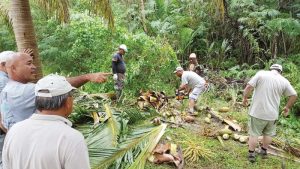30 coconut trees on Rota flagged for rhino beetle infestation

CNMI Quarantine and Department of Lands and Natural Resources personnel chop down affected coconut trees and prepare the debris for incineration. (Contributed Photo)
The Department of Lands and Natural Resources has identified 30 coconut trees in the Tweksberry area on Rota as habitats of the invasive coconut rhinoceros beetles.
To contain the insect and prevent infestation of other coconut trees, DLNR will be closing off the Tweksberry area starting at 6:30pm everyday.
DLNR Secretary Anthony Benavente met with Rota Mayor Efraim M. Atalig yesterday to discuss these ongoing containment and eradication efforts. Benavente was informed by the CNMI Quarantine team about the infested coconut trees in the Tweksberry area.
“The Division of Agriculture, along with our Rota Quarantine team, is working alongside [U.S. Department of Agriculture’s Animal and Plant Health Inspection Service] officials and University of Guam representatives to survey the contaminated areas and will continue to conduct the transferring of all green waste.
“At this time, we’re informing the general public that Tweksberry area will be closed off every day at 6:30pm until further notice to prevent spreading,” Benavente said.
Early last week, James Manglona of CNMI Forestry-Rota said that over 14 coconut rhino beetle breeding traps have been deployed and that an islandwide assessment with the forestry team is ongoing.
“Our team has initiated the removal of affected coconut trees and incineration continues,” Manglona said.
The possible presence of coconut rhinoceros beetles on Rota was discovered only last week after a coconut tree fell to the ground. According to Manglona, 20 adult beetles and many grubs were found in the rotting trunk of the tree.
CNMI State Forester Victor Deleon Guerrero had said that specimens were collected and sent to Guam for professional review.
The acting DLNR secretary at the time, Augustin Kaipat, had said that Dallas Berringer of USDA-APHIS had been notified by Rota Quarantine and that he has instructed to have the specimens of adult and larvae sent to Guam for examination.
The specimens will be reviewed by a National Identifier, who will give the legal authority to provide any support for survey, eradication, and control efforts “and we anticipate official species confirmation toward the end of [this] week,” said Kaipat.
Benavente said that incineration and containment is currently the best possible solution due to limited resources and saltwater saturation.
“At this time, we are also trying to contain the coconut rhino beetle in this area to prevent them from migrating further outward or elsewhere. We are utilizing chainsaws to remove affected trees.
“Coconut rhino beetles hit Guam 10 years ago, made their way to Hawaii four years ago, and we’ve maintained quarantine efforts for an entire decade and we plan to eradicate these pests as aggressively as needed.
“We commend our teams, the mayor of Rota, the Office of the Governor, and our federal partners for their assistance,” Benavente said.
To report a sighting, call CNMI Forestry at 256-3321 or Department of Lands and Natural Resources at 322-9834.



























